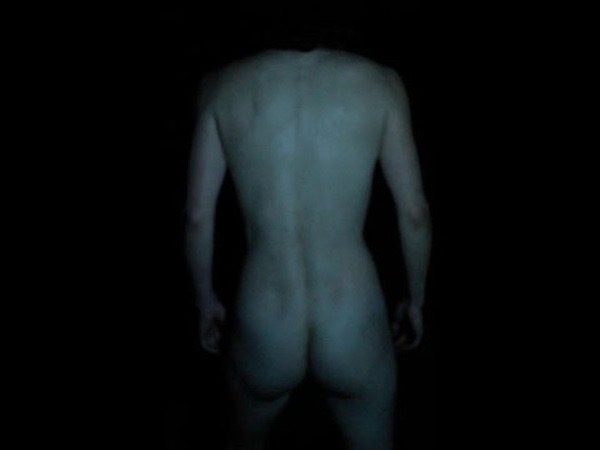
In faint light, a body slowly moves, breaking out from total darkness. Then a second body, a woman. Dream or nightmare? Archaic or essential? Desire or struggle? A journey through the night and the light to the confines of sense and vision. Two years ago, Grandrieux began a trilogy with the theme of “bare life.” Each movement of the trilogy consists of a performance and a film. The first movement, White Epilepsy (2012), has been completed; the second, Meurtrière, is nearing completion. At Radcliffe, he is working on Unrest, the third and final movement, which is marked by dread.
EN
“Cinema is made (above all) with the hands, with the skin, with the entire body, by fatigue, by breath, by the pulsations of the blood, the rhythm of the heart, by the muscles. Body and sensation, that is the machine, its absolute power, its obsession. That is its becoming. Invented bodies, comical, grotesque, obscene, the improbable bodies of the stars and the monsters, and light, its palpitation, and the beating of shots, and in us, fear, joy, hope, sadness, the obscure deployment of human passions.”
Philippe Grandrieux1
“There’s nothing as essential and primal that Philippe Grandrieux has done so far with his cinema than this fifth feature: White Epilepsy (2012) is stripped of all the artifices and narrative pulses of his previous works, and focuses instead in the plausible eroticism of his method, creating a unique and rarefied atmosphere and placing his gaze on the dialogue and the alienation of the body. The downshifting of the movement, the manifestation of darkness and overbearing lightness, the use of crude nature sound are only technical manifestations of a deeper understanding of the senses; the closed diaphragm of the camera lens responds to a manifest necessity of expression.
This time, the primal erotics of Grandrieux’ art have demanded from the filmmaker that all the resources he possesses are used in a minimal, subdued way. Hence what we see is only a dance of bodies which evolves into a hint of ritual cannibalism and gory resemblance, but the implications of those images are immense. This might be Grandrieux best work so far, since all of his previous work has driven him to this: The plasticity of his films, the sensorial experience that leads to the metaphysical connotations of his physical representations, everything is here stripped to the bone. White Epilepsy is, first and foremost, an erotic experience, one of discomfort and rejection of the flesh, a plastic ritual that could easily symbolize something, but that speaks better only in the sensorial plateau of its representation.
In a moment, we see something that resembles a cannibalistic ritual, then we’re confronted to an overexposed image of a woman with blood in her mouth, an action somewhat reminiscent of Denis’ Trouble Every Day, which brings to mind the cannibalization of the other over the excesses and deviations of love. Do the two bodies consume themselves into this empty carcasse that we’re shown at the end of the film? Are these four bodies completely different and dissociated from one another? We’re left to ask ourselves beyond logic answers what was the implication of this last manifestation of Grandrieux behind the camera. Or maybe its significance is irrelevant, since all we’re left with is desolation and spleen. White Epilepsy is a film that depletes the senses, a work of art and a culmination of a process that has given us one of the most solid frameworks of work in this eternal process of reinvention of cinema.”
José Sarmiento Hinojosa2
“Where do images come from? This disturbing and essential question is posed by Philippe Grandrieux, and he already imposed it on himself the start, via Sombre (1999) up to the portrait recently devoted to Masao Adachi (FID 2011). From where, then? Maybe from the depths behind our eyes, ungraspable visions, night in suspension, promise of the end of an eclipse, between dream and nightmare. This is the start (and in truth the programme) of White Epilepsy. In a darkness barely broken by light, a mass advances: a nude back, in a long shot entirely centred on the shoulders. The story (is it a story?) that follows this announcement has the necessity of the elementary: the encounter between this first (feminine) figure with a second masculine one. A familiar scenario. However, a slow-motion ballet between these two bodies takes place. Do we really know what became of Adam and Eve once they were cast out of Paradise? Maybe this is a representation of that. The bodies entwine, rub together, twist together, strip each other and wrestle like moving sculptures framed as a deliberately vertical image. In this choreography, Grandrieux chooses to present gestures from a chthonian, archaic world, full of mute intensities, which ultimately aspires to immobility. The first part of a trilogy to be completed, it is about the frontiers of cinema to be crossed and pushed back into the secluded space of secrets.”
Nicolas Féodoroff3
- 1Philippe Grandrieux, “Sur l’horizon insensé du cinéma”, Cahiers du cinéma hors série: Le siècle du cinema (November 2000). Translated by Maria Palacios Cruz.
- 2José Sarmiento Hinojosa, “Panorama: White Epilepsy by Philippe Grandrieux,” Desistfilm, 28 January 2013.
- 3Nicolas Féodoroff, Film Page White Epilepsy FIDMarseille 2012.

